Varieties
Pandian, Sundaram, Golconda, Jayaram, Evergreen, Athrey, Brookeland, BSS 1, BSS 2, BSS 3, BSS 4, BSS 5, Biclonal seed stocks and Grafts.
Step By Step How to Grow
1) Soil and Climate
Tea requires well drained soil with high amount of organic matter and pH 4.5 to 5.5. The performance of tea is excellent at elevations ranging from 1000 - 2500 m.Optimum temperature: 20 - 270 C.
2) Nursery
The nursery soil should be well drained and deep loam in nature with pH of 4.5 to 4.8. The soil and sand used in the preparation of rooting medium should be tested for pH and nematode infestation.
3) Pre-treatment of rooting medium
Treating with Aluminium sulphate can reduce soil pH. For this purpose the nursery soil is formed into beds of one metre width and about 8 cm height and of a convenient length. Then the beds are drenched with 2% solution of Aluminium sulphate applied at 10 litres/2.5 sq.m of area. Over this another layer of soil of 8 cm height is spread and again drenched with equal quantity of water twice. Then the soil is allowed to dry and the pH is checked before use in the nursery.
4) Preparation of sleeves
Polythene sleeves of 150 or 200 gauge and 10 cm width and 30 - 45 cm length may be used. Drainage holes may be provided at the bottom. The lower 3/4 of the sleeves should be filled with 1:3 sand and soil mixture and the top 1/4 with 1:1 sand and soil mixture and staked in rows. Overhead shade is provided.
5) Selection of mother bush and its treatment
Healthy and vigorously growing high yielding bushes should be selected. Apply to each selected bush with 40 g of young tea mixture + 60:90 NK mixture up to 5 years. The following mixture has to applied before taking the cuttings.
• 0.5 % AlSO4 + 1 % MgSO4 (before 3 weeks)
• 2 % Zn SO4 (before 2 weeks)
• 1 % Urea (before 1 week)
6) Propagation
Stem cuttings of 60 - 120 cm
7) Spacing
• Plains: 2.0 to 2.5 m X 1.2 – 1.5 m
• Hills: 1.5 x 1.5 m
6) Preparation of cuttings
Cuttings are taken on April - May and August - September. Semi hard-wood cuttings are prepared with one leaf and an internode with a slanting cut at the bottom.
7) Planting of cuttings
The sleeves are watered thoroughly and holes are made in the soil. The cuttings are inserted in the hole and the soil around is pressed firmly to avoid airspace followed by watering. Small polythene tents may be provided which maintain high humidity and regulate the temperature inside. Cuttings may take 10 - 12 weeks for rooting. After 90 days i.e. when all the cuttings have rooted, the polythene tent may be removed gradually over a period of 10 - 15 days.
8) Manuring of nursery
After the tent is removed the cuttings are sorted and staked. 30 g of Nursery soluble mixture of the following composition dissolved in 10 litres of water may be applied over an area of 4 sq.m. This should be done fortnightly.
9) Composition of the fertilizer
Ammonium phosphate (20:20)=35 parts by Wt
Potassium sulphate=15 parts by Wt
(or)
MOP=12 parts by Wt
Magnesium sulphate=15 parts by Wt
Zinc sulphate =3 parts by Wt
Total=80 parts by Wt
10) Hardening of the cuttings
Hardening of 4 - 6 months old young cuttings should be done by removing shade gradually in stages over a period of 4 - 6 weeks starting from a few hours exposure to sun every day initially and extending the time of exposure gradually.
Methods of planting
Single Hedge System
In this method, the spacing adopted is 1.20 x 0.75 m accommodating 10,800 plants/ha.
Double Hedge System
In this method, the spacing adopted is 1.35 x 0.75 x 0.75 m accommodating 13,200 plants/ha.
Season and planting
May - June or September - October
Sleeves should be opened lengthwise without injuring the roots and planted in the pit and the soil is gently pressed.
Irrigation
Subsoil irrigation may be given for young tea seedlings during summer months.
Manuring
Manuring should be done 2 months after planting. Phosphorous should be applied at 80 - 100 kg/ha as Rock phosphate once in a year by placement at 15 - 25 cm depth up to the first pruning and thereafter once in two years. N : K ratio 2 : 3 should be adapted for the first 3 years and a ratio 1 : 1 thereafter.
| Year of application |
Total weight kg/ha/annum |
No. of applications |
Qty/plant (g) |
| N |
K |
Ammonium Sulphate |
Urea |
| I year |
180 |
270 |
5 |
13 |
27 |
| II year |
240 |
360 |
6 |
23 |
15 |
| III year |
300 |
450 |
6 |
29 |
18 |
| IV year onwards |
300 |
300 |
6 |
33 |
19 |
Application of fertilizers should be done before the onset of monsoon. Fertilizers should be broadcast around the drip circle avoiding contact with the collar.
Aftercultivation
Perennial grasses (Forbicot weeds) can be controlled by spraying Glyphosate 1.75 lit + Kaoline 2 lit + 2 kg of wetting agent in 450 lit. of water followed by Gramoxone 500 ml in 200 lit of water to control dicot weeds.
Training young tea
Centering
To induce more laterals, centering should be done 3 - 5 months after planting. The main leader stem should be cut, leaving 8 - 10 matured leaves.
Tipping
Tipping is done at a height of 35 cm from the second tipping at 60 cm from ground level.
Pruning
Pruning is done to maintain convenient height of bush and to remove dead and diseased branches.
Area to be pruned every year = Total extent of the garden/ Pruning cycle
Pruning interval = (Elevation in feet / 1000) + 1
Pruning should be done in April - May or August - September.
Harvest and Yield
Harvest
The pods are ready for harvest in 6 to 9 months after flowering. The matured beans change colour from green to pale yellow. The right picking stage is when the distal end of the pod turns yellow. Daily picking of matured pod is essential. The pods are harvested by cutting with a knife.
Yield
• Average cured bean yield is 300 to 600 kg / ha / year.
• 6 kg of green pods produces 1 kg of cured beans.
• The economic life of vine is 12 – 14 years.
Types of pruning
Rejuvenation pruning
The whole bush should be cut near the ground level less than 30 cm with a view to rejuvenate the bushes.
Hard pruning
Hard/ formation pruning of young tea is done at 30 to 45 cm (12" to 18") for proper spread of bushes.
Medium pruning
To check the bush growing to an inconvenient height this type of pruning is done in order to stimulate new wood and to maintain the foliage at lower levels less than 60 cm.
Light pruning
Pruning depends on the previous history of the bush raising the height of medium pruning by an inch or less to manageable heights for plucking (less than 65 cm).
Skiffing
This is the lightest of all pruning methods. A removal of only the top 5 - 8 cm new growth is done so as to obtain a uniform level of pruning surface (more than 65 cm).
Shade regulation
Pollarding of shade trees should be done prior to heavy rains at a height of 8 - 10 m from the ground level.
Annual lopping
Cutting the erect type branches on the laterals in shade trees before monsoon season.
Plant protection
Scales
Scales can be controlled by spraying Carbaryl 50 WP @ 2 g/lit. or Quinalphos 25 EC @ 2 ml/lit or Chlorpyriphos 20 EC @ 2 ml/lit.
Sahydrassis / Phassus borer
Locate the particle mat covering at the base tea bush and remove.
Insert a thick wire in the bore hole to kill the larvae.
Thrips
Spray any one of the following insecticide
| Insecticide |
Dose |
| Azadirachtin 5 % Neem extract concentrate |
5.0 ml/10 lit. |
| Azadirachtin 1.0 % EC (neem based) |
2.0 ml/lit. |
| Ethion 50%EC |
5.0 ml/10 lit. |
| Profenofos 50 % EC |
2.0 ml/lit. |
| Quinalphos 25 % EC |
7.5 ml/10 lt |
Aphids
Spray phosalone 35 % EC @ 2.0 ml/lit
Red spider mite, Pinkmite, scarlet mite
| Insecticide |
Dose |
| Azadirachtin 5 % Neem extract concentrate |
5.0 ml/10 lit. |
| Azadirachtin 1.0 % EC (neem based) |
2.0 ml/lit. |
| Dicofol 18.5 % SC |
2.0 ml/lit. |
| Ethion 50%EC |
5.0 ml/10 lit. |
| Fenazaquin 10 % EC |
1.6 ml/lit |
| Fenpyroximate 5 % EC |
1.2 ml/lit |
| Flumite 20%SC/flufenzine 20%SC |
5.0 ml/10 lit |
| Hexythiazox 5.45% EC |
1.2 ml/lit |
| Phosalone 35 % EC |
1.0 ml/lit |
| Profenofos 50 % EC |
2.0 ml/lit. |
| Propargite 57 % EC |
2.0 ml/lit. |
| Spiromesifen 22.9 % SC |
1.0 ml/lit. |
Tea mosquito bug:
Monitoring the incidence of tea mosquito bugs at regular intervals.
Removal of alternate hosts like neem, cashew, guava in the surroundings
When the infestation is lesser: Spraying of any one of the following:
1. Imidacloprid (0.6 ml/l)
2. Thiamethoxan (0.6 g /l)
3. Profenophos (2 ml/l).
Diseases
Blister blight
Blister blight can be controlled by adopting the following control measures.
• Spray 210 g Copper oxychloride and Nickel chloride per ha at 5 days interval from June - September; 11 days intervals in October and November.
• Spray Hexagonazole 200 ml + Copper oxychloride 210 g 5 days interval/ha (or)
Crop duration and Yield
Plucking commences when the tea bush is 3 years old. The plucking of extreme tip of the growing branch consists of an unopened bud together with two leaves is popularly known as "Two leaves and a bud", while fine plucking is anything less than this. In South India plucking continues throughout the year at weekly intervals during March - May and at intervals of 10 -14 days during the other months.
Rush period
During rush period harvesting is done at 7 to 10 days interval.
Lean period
During lean period harvesting is done at 10 – 15 days interval.
Yield
The yield of green leaves is 10 t/ha
Market information
| Growing Districts |
Nilgiris, Coimbatore, Dindigul, Theni, Kanyakumari and Tirunelveli districts
|
| Major markets in Tamil Nadu |
Coimbatore, Nilgiris |
| Grade specification |
Size of the tea leaves : Whole, large tea – Higher
grading
Method of production : CTC process (Crush, Tear and
Curl) and Orthodox
|
Types of Tea
Different Types of Tea
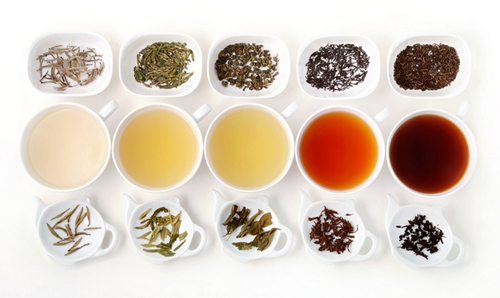
Black Tea
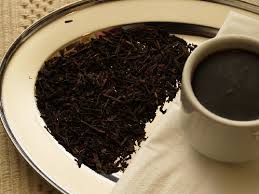
Green Tea
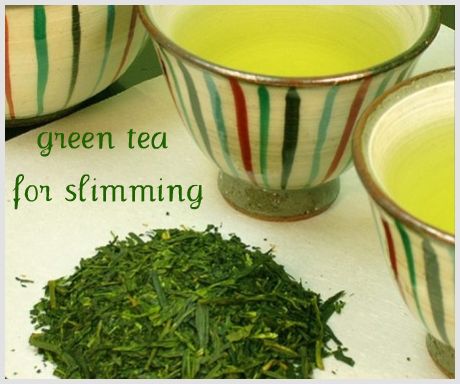
Tea Grades

Tea Processing Steps
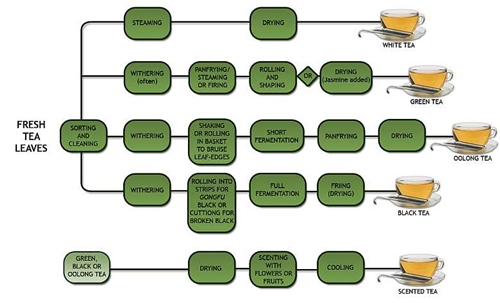
Tea Production Map of World

Tea Production Map of India
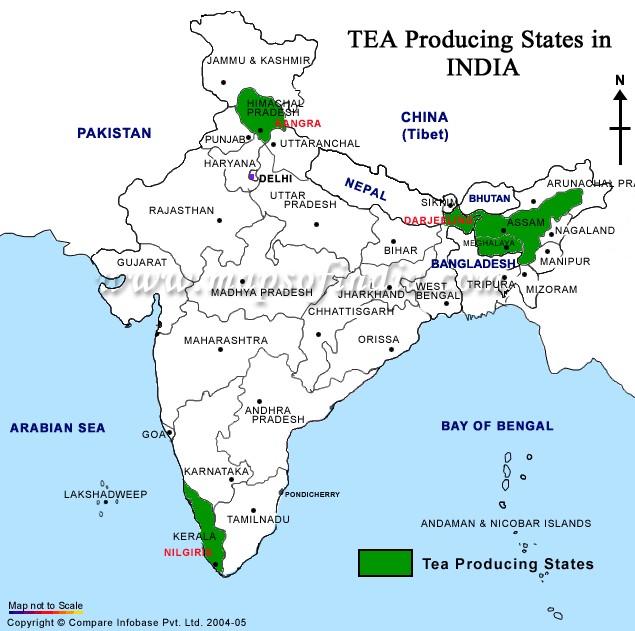
Video